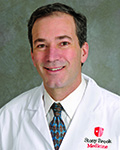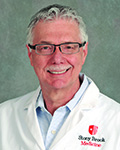Ask the Experts
 |
Alexander Dagum, MD Professor and Chief Plastic and Reconstructive Surgery |
 |
Leon Klempner, DDS Orthodontics Stony Brook University School of Dental Medicine |
You probably know someone born with a cleft lip or palate — it’s among the most common types of birth defects. But did you know that one of the nation’s premier cleft palate teams is as close as Stony Brook Children’s Hospital? The multidisciplinary, nationally accredited Stony Brook Cleft Palate Craniofacial Center has played a key role in the lives of hundreds of children born with craniofacial differences. Here, plastic surgeon Dr. Alexander Dagum and orthodontist Dr. Leon Klempner talk about what kids with clefts need over the course of their childhood — and how Stony Brook helps them.
What is a cleft and how does it occur?
“Cleft” means there is a split or opening – either in the lip, the palate (the roof of the mouth) or both. This occurs during the first trimester of pregnancy, when the two sides of the lip and palate form separately, then fuse together during development. If they do not fuse correctly, a cleft can occur. There are a number of factors that come together and cause a cleft — including a genetic predisposition, but this is usually not the sole cause.
What’s the best medical approach?
The American Cleft Palate-Craniofacial Association recommends that each child be followed by a multidisciplinary cleft palate team. We agree. The team approach is ideally suited for children with clefts because they often require the care of many specialists in phases that occur from birth to adulthood. When all of these specialists are part of a unified team, better communication and coordination of services occur. Another benefit of working with a team like ours is convenience for the family. Our team evaluates the patient and answers the family’s questions in a consolidated time frame so that parents aren’t juggling multiple appointments. And we have a dedicated team coordinator to ensure follow-through and coordination of services.
What surgical or other procedures may be necessary for these children?
Care is based on the type and severity of the clefts, as well as the child’s overall health and developmental needs. A cleft lip is usually repaired at about three months, and a cleft palate usually at around 1 year of age, prior to speech development. Myringotomy (ear) tubes are usually placed at the time of cleft repair. As they grow and develop, however, many children with clefts will require additional procedures and surgeries. Plastic surgeons, pediatric dentists, oral-maxillofacial surgeons, orthodontists, otolaryngologists (ENT) and other specialists all may play a role. For example, children between ages 6 to 9 may need an alveolar bone graft and fistula repair. This procedure creates bone for permanent teeth to erupt, and closes any remaining fistulas (openings) between the gum and nose. Another procedure that some cleft patients require is orthognathic (jaw) surgery to correct underdevelopment of the upper jaw. It’s usually done when the child is older and finished growing.
What other services are needed?
Our feeding and lactation consultants help with newborns that may have difficulty nursing. Audiologists, speech pathologists and speech therapists provide assistance with potential hearing and speech problems. Our pediatric dentist helps keep the patient’s teeth and gums as healthy as possible. Multiple phases of complex orthodontic care are usually required as well. Our team also includes psychologists, social workers, nurses and genetic counselors.
What distinguishes our center?
We’re attuned to the psychosocial needs of child and family. Working as a team with the child’s parents and pediatrician, the cleft palate and craniofacial team addresses the child’s emotional, social and developmental needs, as well as their medical requirements. Our goal is make treatment as least traumatic as possible.
We also bring an extraordinary level of experience. Our specialists have been working together for years – in some cases, decades. And we are one of just five cleft teams in metro New York with full accreditation from the American Cleft Palate-Craniofacial Association.
We’ve treated thousands of patients from Long Island and across the globe — our team members travel the world helping children with craniofacial abnormalities, and many patients come to Stony Brook from overseas to seek care. In fact, the surgeons in our program have made history performing some of the most complex procedures ever done worldwide.
For more information, call (631) 444-KIDS.
All health and health-related information contained in this article is intended to be general and/or educational in nature and should not be used as a substitute for a visit with a healthcare professional for help, diagnosis, guidance, and treatment. The information is intended to offer only general information for individuals to discuss with their healthcare provider. It is not intended to constitute a medical diagnosis or treatment or endorsement of any particular test, treatment, procedure, service, etc. Reliance on information provided is at the user's risk. Your healthcare provider should be consulted regarding matters concerning the medical condition, treatment, and needs of you and your family. Stony Brook University/SUNY is an affirmative action, equal opportunity educator and employer.

